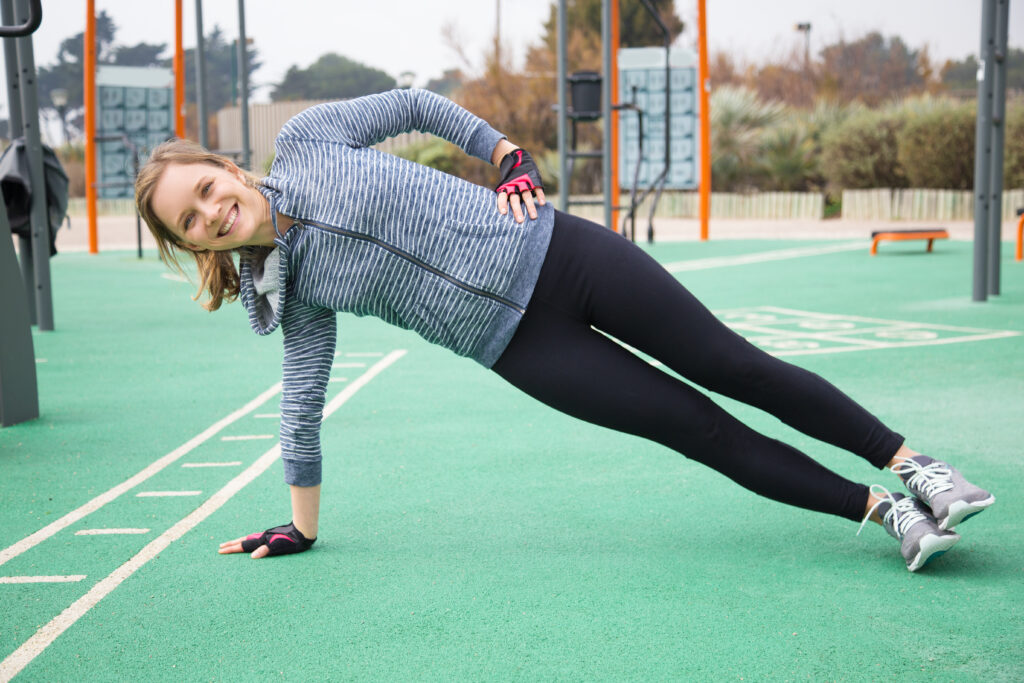Introduction
Core exercises like the dead bug, side bridge, and bird dog are foundational movements that go beyond building visible abs—they strengthen the deep stabilizing muscles essential for overall health and performance. These exercises improve (1) core stability, (2) enhance spinal health, and (3) promote better balance and posture. Unlike traditional crunches, they target multiple muscle groups, including the transverse abdominis, obliques, and glutes, while also reducing the risk of injury.
Incorporating these low-impact yet highly effective movements into your routine ensures a stronger, more functional core that supports both daily activities and athletic pursuits. Let’s break down each one for you, to give you more insight into why you should be adding each to your Jefit strength program.
1. Dead Bug Core Exercise
The dead bug is a core stabilization exercise that primarily targets the deep core muscles. Here’s a breakdown of the main muscle groups it works:
- Rectus Abdominis – This is the “six-pack” muscle that runs along the front of your abdomen. The Dead Bug helps strengthen this muscle by forcing it to maintain tension during movement.
- Transverse Abdominis – The deepest abdominal muscle, which wraps around your torso like a corset, is heavily engaged. It helps stabilize the spine and pelvis during the exercise.
- Obliques – Both internal and external obliques are activated to maintain core stability and resist rotational forces.
- Hip Flexors – Specifically, the iliopsoas muscles, which assist in lifting the legs, are engaged during the leg-lowering part of the movement.
- Lower Back (Erector Spinae) – The Dead Bug promotes core stability while keeping the lower back flat against the floor, indirectly strengthening the muscles that support the spine.
- Shoulders and Chest – While the movement isn’t primarily focused on these areas, keeping your arms extended and controlling the movement helps engage the deltoids and pectorals.
The dead bug is great for improving core stability and coordination without putting excessive strain on the lower back, making it ideal for various fitness levels.
2. Benefits of the Side Bridge
- Strengthens the Core
- The side bridge emphasizes the obliques, crucial for rotational stability and lateral movements. A strong core improves athletic performance and reduces the risk of injuries.
- Improves Spinal Stability
- By engaging the transverse abdominis and other deep core muscles, the exercise promotes proper alignment of the spine, reducing lower back pain and improving posture.
- Targets the Gluteus Medius
- Side bridges engage the gluteus medius, essential for hip stability during walking, running, or standing on one leg.
- Enhances Shoulder Stability
- Holding your body weight on one arm strengthens the stabilizing muscles in the shoulders, particularly the deltoids and rotator cuff.
- Low Impact and Versatile
- This exercise is gentle on the joints and can be modified for various fitness levels, making it suitable for beginners and advanced athletes alike.
Muscles Worked
The side bridge is a comprehensive core exercise that also activates surrounding stabilizing muscles:
- Primary Muscles:
- Obliques (internal and external)
- Transverse Abdominis
- Rectus Abdominis
- Secondary Muscles:
- Gluteus Medius (hip stability)
- Gluteus Maximus
- Quadratus Lumborum (a deep back muscle)
- Supporting Muscles:
- Deltoids (shoulder stability)
- Latissimus Dorsi (lats)
- Adductors and Abductors (inner and outer thighs)

How to Perform a Side Bridge
Follow these steps for proper form and maximum effectiveness:
Starting Position
- Lie on your side on a mat. Position your elbow directly under your shoulder with your forearm perpendicular to your body.
- Stack your legs on top of each other, keeping your body straight from head to heels. Beginners can modify by bending the knees.
Execution
- Engage Your Core: Tighten your abdominal muscles to maintain a neutral spine.
- Lift Your Hips: Press through your forearm and feet to raise your hips off the ground, forming a straight line from your head to your feet.
- Hold the Position: Keep your hips level and avoid sagging or rotating. Your upper arm can rest on your side or extend upward for balance.
- Breathe: Maintain steady breathing throughout the hold.
Duration and Progression
- Hold the side bridge for 15–30 seconds per side, gradually increasing as your strength improves. Aim for 2–3 sets on each side.
- To progress, try:
- Side Bridge with Hip Dips: Lower your hips slightly toward the ground and lift them back up.
- Side Bridge with Leg Lift: Raise the top leg while maintaining stability.
Common Mistakes to Avoid
- Letting Hips Sag: Keep your body aligned to avoid unnecessary strain on the lower back.
- Overloading the Shoulder: Ensure your elbow is directly under your shoulder for proper weight distribution.
- Arching the Back: Engage your core to maintain a straight line from head to heels.
Tips for Success
- Focus on Alignment: A straight spine and neutral pelvis are essential for maximizing effectiveness and avoiding injury.
- Warm Up: Incorporate light stretches or dynamic movements to prepare your core and shoulders.
- Modify if Needed: Beginners can start with bent knees or shorter holds to build strength.
By incorporating the side bridge into your workouts, you’ll develop a stronger core, better stability, and reduced risk of injury, making it a valuable addition to any fitness routine.
3. Add the Bird Dog Exercise to Your Core Routine
The bird dog exercise is a dynamic and functional movement that engages the core while promoting stability and balance. It’s a foundational exercise often included in physical therapy, strength training, and core-focused workouts.
Enhances Core Stability
- The bird dog works the deep core muscles, particularly the transverse abdominis, which plays a crucial role in stabilizing the spine and pelvis.
- This exercise challenges the core by requiring balance and coordination, helping to improve stability during both static and dynamic movements.
Improves Balance and Coordination
- By extending opposite limbs simultaneously, the bird dog helps develop neuromuscular coordination and enhances your ability to maintain balance.
- This benefit translates well into daily activities and sports, improving overall body control.
Promotes Spinal Health
- The bird dog strengthens the multifidus, a small but vital muscle group that supports the spine.
- It’s often recommended for individuals with lower back pain, as it provides spinal stabilization without compressive loads, making it a safe and effective rehabilitation exercise.
Builds Functional Strength
- Unlike isolated core exercises, the bird dog trains multiple muscle groups synergistically, mimicking real-life functional movements where coordination between limbs and core is essential.
- It strengthens not only the core but also the glutes, deltoids, hamstrings, and erector spinae.
Enhances Posture
- The bird dog encourages proper alignment of the spine and pelvis, improving posture over time.
- By strengthening the muscles that support upright positioning, it helps counteract the negative effects of prolonged sitting or poor posture.
Reduces Injury Risk
- The bird dog emphasizes controlled movement, which teaches the body to stabilize the spine during challenging or asymmetrical motions, reducing the risk of injuries during workouts or daily activities.
- It also targets smaller stabilizing muscles that often go undertrained in traditional core exercises.
Accessible for All Fitness Levels
- The bird dog is a low-impact exercise that’s easy to modify, making it suitable for beginners, older adults, and advanced athletes alike.
- Variations like holding each position longer or adding resistance bands can make it more challenging.
Enhances Athletic Performance
- A strong and stable core is critical for performance in sports and activities that involve running, jumping, or rotational movements. The bird dog helps athletes improve their force transfer from the core to the limbs.
Conclusion
Adding our three suggested exercises to your Jefit core routine provides numerous benefits, from improving stability and posture to enhancing functional strength and reducing injury risk. There versatility and accessibility make all of them must-have exercises for anyone looking to develop a stronger, healthier core.
Stay Strong Together
If you’re serious about nutrition, building muscle and reaching your fitness goals in 2025, then the Jefit app is the perfect tool to help get you there! With over 20 million downloads and more than 12 million bodybuilders using the app to track their workouts, Jefit is the ultimate strength training companion. Rated as the 2024 Best App and featured by top publications like Men’s Health, PC Magazine, and USA TODAY. Jefit boasts 42,000+ five-star ratings for its user-friendly design and comprehensive features. Whether you’re focused on protein intake, building strength, or tracking your progress, Jefit has everything you need to succeed. Download Jefit today and join millions of fitness enthusiasts transforming their bodies!
- Best Time to Hold a Stretch: What Science Says (30 to 180 sec.) - July 14, 2025
- How Wearable Tech is Revolutionizing Strength Training - July 11, 2025
- Why Recovery Time Between Sets Matters for Muscle Growth - July 9, 2025
